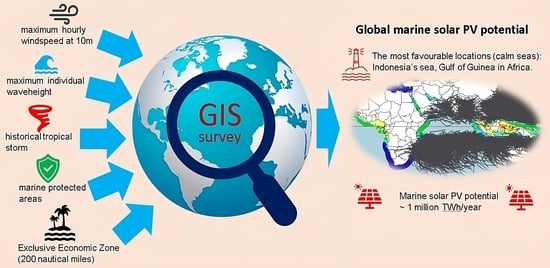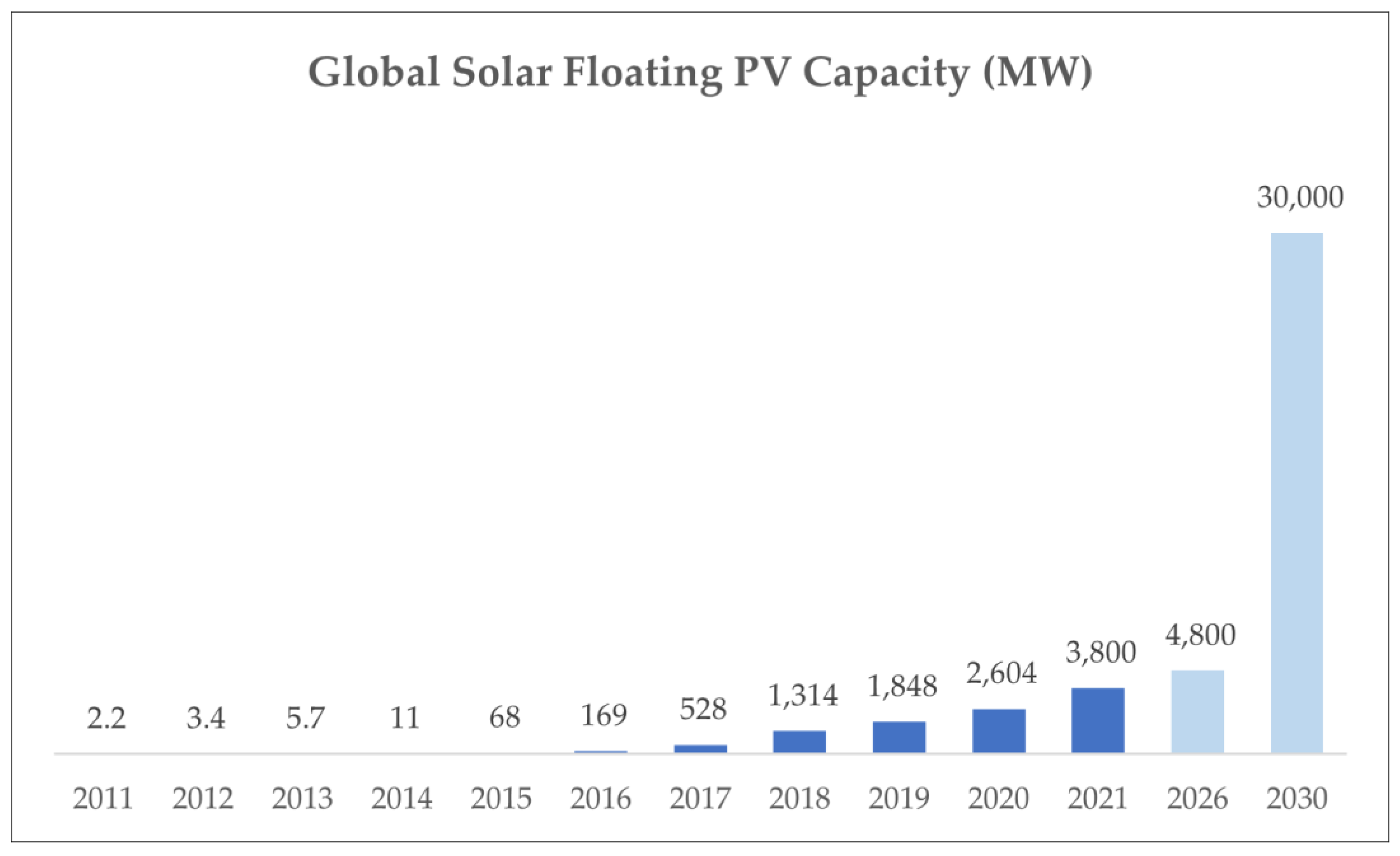Global Atlas of Marine Floating Solar PV Potential
Abstract
:1. Introduction
2. Materials and Methods
2.1. Floating PV Technology
2.2. Wind and Wave from ERA5 Reanalysis
3. Methodology
4. Results and Discussion
4.1. Southeast Asia (Region I)
4.2. The Middle East (Region II)
4.3. The Mediterranean and Black Sea (Region III)
4.4. Africa (Region IV)
4.5. South America (Region V)
5. Conclusions
Supplementary Materials
Author Contributions
Funding
Institutional Review Board Statement
Informed Consent Statement
Data Availability Statement
Conflicts of Interest
References
- Blakers, A. Despairing about Climate Change? These 4 Charts on the Unstoppable Growth of Solar May Change Your Mind. Available online: https://theconversation.com/despairing-about-climate-change-these-4-charts-on-the-unstoppable-growth-of-solar-may-change-your-mind-204901 (accessed on 4 June 2023).
- Net Zero by 2050—Analysis—IEA. Available online: https://www.iea.org/reports/net-zero-by-2050 (accessed on 15 May 2023).
- World Energy Transitions Outlook. Available online: https://www.irena.org/publications/2021/Jun/World-Energy-Transitions-Outlook (accessed on 4 June 2023).
- Energy Data Explorer—Our World in Data. Available online: https://ourworldindata.org/explorers/energy?tab=table&%3Bfacet=none&%3Bcountry=USA~GBR~CHN~OWID_WRL~IND~BRA~ZAF&%3BTotal+or+Breakdown=Total&%3BEnergy+or+Electricity=Electricity+only&%3BMetric=Annual+generation (accessed on 4 June 2023).
- Lu, B.; Blakers, A.; Stocks, M.; Cheng, C.; Nadolny, A. A Zero-Carbon, Reliable and Affordable Energy Future in Australia. Energy 2021, 220, 119678. [Google Scholar] [CrossRef]
- World Population Prospects—Population Division—United Nations. Available online: https://population.un.org/wpp/Download/Standard/CSV/ (accessed on 15 May 2023).
- The World Bank and the International Finance Corporation Global Solar Atlas. Available online: https://globalsolaratlas.info/map (accessed on 4 June 2023).
- Agricultural Area over the Long-Term, 1600 to 2016. Available online: https://ourworldindata.org/grapher/total-agricultural-area-over-the-long-term (accessed on 4 June 2023).
- Global Wind Atlas. Available online: https://globalwindatlas.info/en/area/Indonesia?print=true (accessed on 22 January 2021).
- Bontempo Scavo, F.; Tina, G.M.; Gagliano, A.; Nižetić, S. An Assessment Study of Evaporation Rate Models on a Water Basin with Floating Photovoltaic Plants. Int. J. Energy Res. 2021, 45, 167–188. [Google Scholar] [CrossRef]
- Trapani, K.; Redõn Santafé, M. A Review of Floating Photovoltaic Installations: 2007–2013. Prog. Photovolt. Res. Appl. 2015, 23, 524–532. [Google Scholar] [CrossRef] [Green Version]
- Solar Energy Research Institute of Singapore. Where Sun Meets Water: Floating Solar Market Report; Solar Energy Research Institute of Singapore: Singapore, 2019. [Google Scholar]
- Center for International Earth Science Information Network at Columbia University. Percentage of Total Population Living in Coastal Areas; Center for International Earth Science Information Network at Columbia University: New York, NY, USA, 2017. [Google Scholar]
- The OCEAN Conference. Ocean Fact Sheet Package. Available online: https://www.un.org/sustainabledevelopment/wp-content/uploads/2017/05/Ocean-fact-sheet-package.pdf (accessed on 21 July 2023).
- Kumar, M.; Mohammed Niyaz, H.; Gupta, R. Challenges and Opportunities towards the Development of Floating Photovoltaic Systems. Sol. Energy Mater. Sol. Cells 2021, 233, 111408. [Google Scholar] [CrossRef]
- Sahu, A.; Yadav, N.; Sudhakar, K. Floating Photovoltaic Power Plant: A Review. Renew. Sustain. Energy Rev. 2016, 66, 815–824. [Google Scholar] [CrossRef]
- Oliveira-Pinto, S.; Stokkermans, J. Marine Floating Solar Plants: An Overview of Potential, Challenges and Feasibility. Proc. Inst. Civ. Eng.—Marit. Eng. 2020, 173, 120–135. [Google Scholar] [CrossRef]
- Cazzaniga, R.; Rosa-Clot, M. The Booming of Floating PV. Sol. Energy 2021, 219, 3–10. [Google Scholar] [CrossRef]
- Golroodbari, S.Z.; van Sark, W. Simulation of Performance Differences between Offshore and Land-Based Photovoltaic Systems. Prog. Photovolt. Res. Appl. 2020, 28, 873–886. [Google Scholar] [CrossRef]
- Testing the Waters with Floating Solar Plants|Energy Global. Available online: https://www.energyglobal.com/special-reports/11042023/testing-the-waters-with-floating-solar-plants/ (accessed on 15 May 2023).
- International Renewable Energy Agency Energy from the Sea: An Action Agenda for Deploying Offshore Renewables Worldwide. Available online: https://www.irena.org/events/2021/May/An-Action-Agenda-for-Deploying-Offshore-Renewables-Worldwide (accessed on 15 May 2023).
- Floating PV: On the Rise in Europe—Intersolar Europe. Available online: https://www.intersolar.de/market-trends/floating-pv-europe (accessed on 4 June 2023).
- Power Plant Profile: Saemangeum Floating Solar Power Project, South Korea. Available online: https://www.power-technology.com/marketdata/power-plant-profile-saemangeum-floating-solar-power-project-south-korea/ (accessed on 20 May 2023).
- Global Industry Analysts, Inc. Global Industry Analysts Predicts the World Floating Solar Panels Market to Reach 4.8 Thousand MW by 2026; Global Industry Analysts, Inc.: San Jose, CA, USA, 2022. [Google Scholar]
- Ocean Sun Has Signed a Technology License Agreement for 0.5 MWp Offshore Pilot in Haiyang, Shandong, China|Ocean Sun. Available online: https://oceansun.no/ocean-sun-has-signed-a-technology-license-agreement-for-0-5-mwp-offshore-pilot-in-haiyang-shandong-china/ (accessed on 22 May 2023).
- Climate Reanalysis|Copernicus. Available online: https://climate.copernicus.eu/climate-reanalysis (accessed on 4 June 2023).
- Hersbach, H.; Bell, B.; Berrisford, P.; Hirahara, S.; Horányi, A.; Muñoz-Sabater, J.; Nicolas, J.; Peubey, C.; Radu, R.; Schepers, D.; et al. The ERA5 Global Reanalysis. Q. J. R. Meteorol. Soc. 2020, 146, 1999–2049. [Google Scholar] [CrossRef]
- Graham, R.M.; Hudson, S.R.; Maturilli, M. Improved Performance of ERA5 in Arctic Gateway Relative to Four Global Atmospheric Reanalyses. Geophys. Res. Lett. 2019, 46, 6138–6147. [Google Scholar] [CrossRef] [Green Version]
- Tetzner, D.; Thomas, E.; Allen, C. A Validation of ERA5 Reanalysis Data in the Southern Antarctic Peninsula—Ellsworth Land Region, and Its Implications for Ice Core Studies. Geosciences 2019, 9, 289. [Google Scholar] [CrossRef] [Green Version]
- Belmonte Rivas, M.; Stoffelen, A. Characterizing ERA-Interim and ERA5 Surface Wind Biases Using ASCAT. Ocean Sci. 2019, 15, 831–852. [Google Scholar] [CrossRef] [Green Version]
- Olauson, J. ERA5: The New Champion of Wind Power Modelling? Renew. Energy 2018, 126, 322–331. [Google Scholar] [CrossRef] [Green Version]
- Kalverla, P.C.; Duncan, J.B., Jr.; Steeneveld, G.-J.; Holtslag, A.A.M. Low-Level Jets over the North Sea Based on ERA5 and Observations: Together They Do Better. Wind Energy Sci. 2019, 4, 193–209. [Google Scholar] [CrossRef] [Green Version]
- Wang, J.; Wang, Y. Evaluation of the ERA5 Significant Wave Height against NDBC Buoy Data from 1979 to 2019. Mar. Geod. 2022, 45, 151–165. [Google Scholar] [CrossRef]
- ERA5: How to Calculate Wind Speed and Wind Direction from u and v Components of the Wind?—Copernicus Knowledge Base—ECMWF Confluence Wiki. Available online: https://confluence.ecmwf.int/pages/viewpage.action?pageId=133262398 (accessed on 15 May 2023).
- ERA5 Hourly Data on Single Levels from 1940 to Present. Available online: https://cds.climate.copernicus.eu/cdsapp#!/dataset/reanalysis-era5-single-levels?tab=overview (accessed on 15 May 2023).
- Knapp, K.R.; Kruk, M.C.; Levinson, D.H.; Diamond, H.J.; Neumann, C.J. The International Best Track Archive for Climate Stewardship (IBTrACS). Bull. Am. Meteorol. Soc. 2010, 91, 363–376. [Google Scholar] [CrossRef] [Green Version]
- Naval Meteorology and Oceanography Command Western North Pacific Ocean Best Track Data. Available online: https://www.metoc.navy.mil/jtwc/jtwc.html?western-pacific (accessed on 15 May 2023).
- Naval Meteorology and Oceanography Command Southern Hemisphere Best Track Data. Available online: https://www.metoc.navy.mil/jtwc/jtwc.html?southern-hemisphere (accessed on 15 May 2023).
- Naval Meteorology and Oceanography Command North Indian Ocean Best Track Data. Available online: https://www.metoc.navy.mil/jtwc/jtwc.html?north-indian-d (accessed on 15 May 2023).
- National Centers for Environmental Information (NCEI). Available online: https://www.ncei.noaa.gov/ (accessed on 4 June 2023).
- Tropical Cyclone—Weather Satellites, Aircraft Reconnaissance, and El Niño/La Niña|Britannica. Available online: https://www.britannica.com/science/tropical-cyclone/Tracking-and-forecasting (accessed on 16 May 2023).
- Marine and Land Zones: The Union of World Country Boundaries and EEZs. Available online: https://www.marineregions.org/sources.php#unioneezcountry (accessed on 15 May 2023).
- The World Database on Protected Areas (WDPA). Available online: https://www.protectedplanet.net/en/thematic-areas/wdpa?tab=WDPA (accessed on 15 May 2023).
- Silalahi, D.F.; Blakers, A.; Stocks, M.; Lu, B.; Cheng, C.; Hayes, L. Indonesia’s Vast Solar Energy Potential. Energies 2021, 14, 5424. [Google Scholar] [CrossRef]
- Persian Gulf|Gulf, Middle East|Britannica. Available online: https://www.britannica.com/place/Persian-Gulf (accessed on 31 May 2023).
- Red Sea|Sea, Middle East|Britannica. Available online: https://www.britannica.com/place/Red-Sea (accessed on 31 May 2023).
- Nigeria: Population Forecast 2025–2050|Statista. Available online: https://www.statista.com/statistics/1122955/forecast-population-in-nigeria/ (accessed on 4 June 2023).
- Countries by Population Density|Countries by Density 2023. Available online: https://worldpopulationreview.com/country-rankings/countries-by-density (accessed on 4 June 2023).
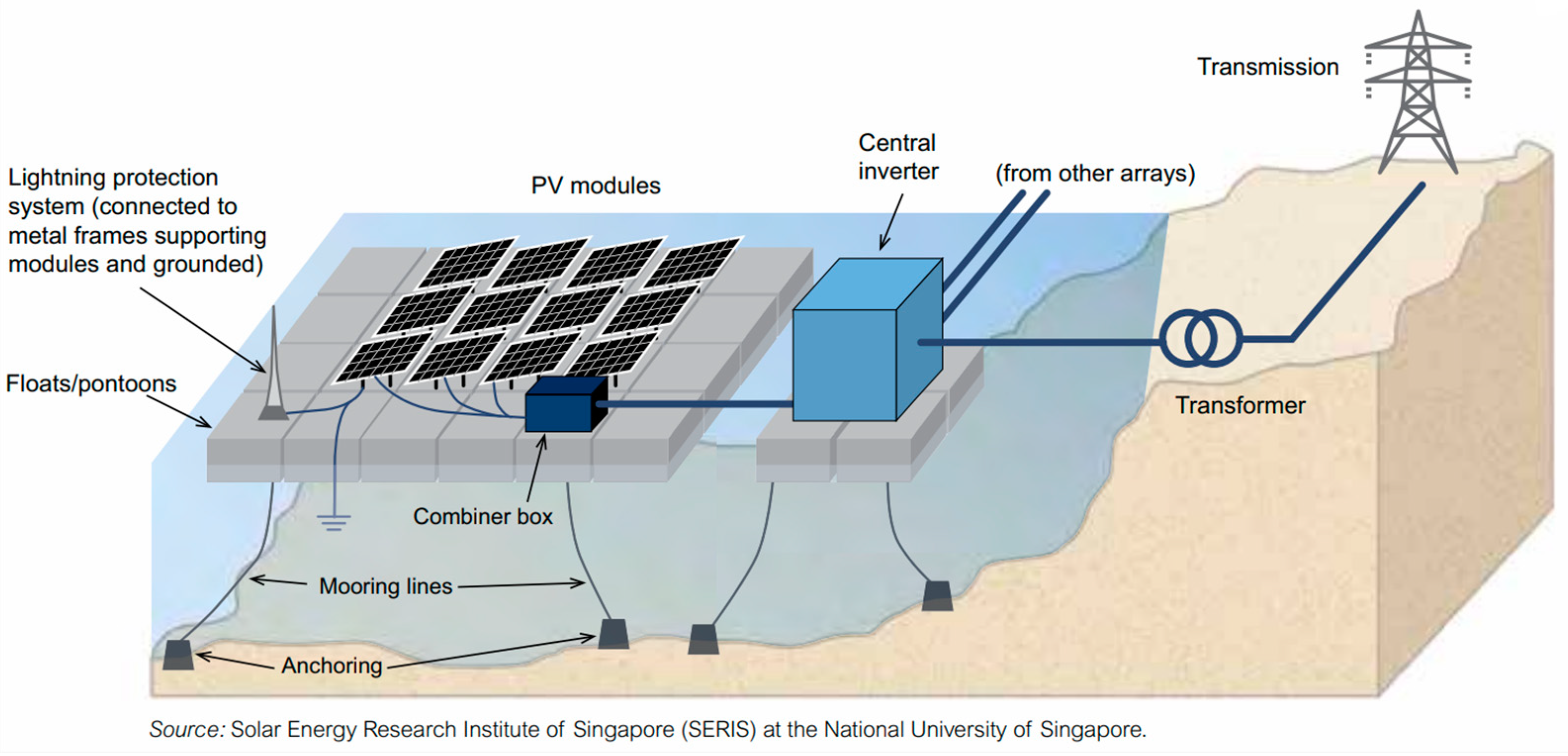
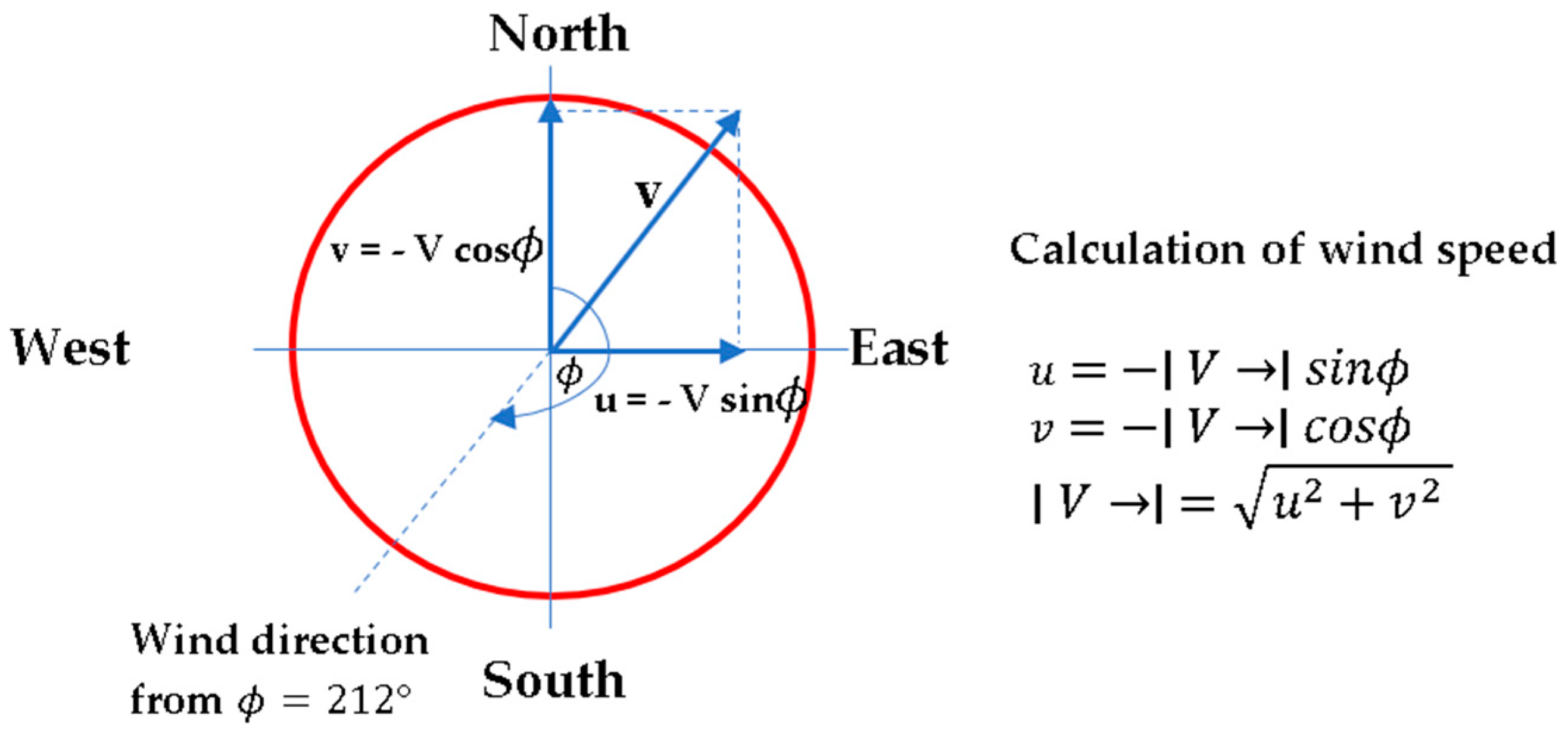
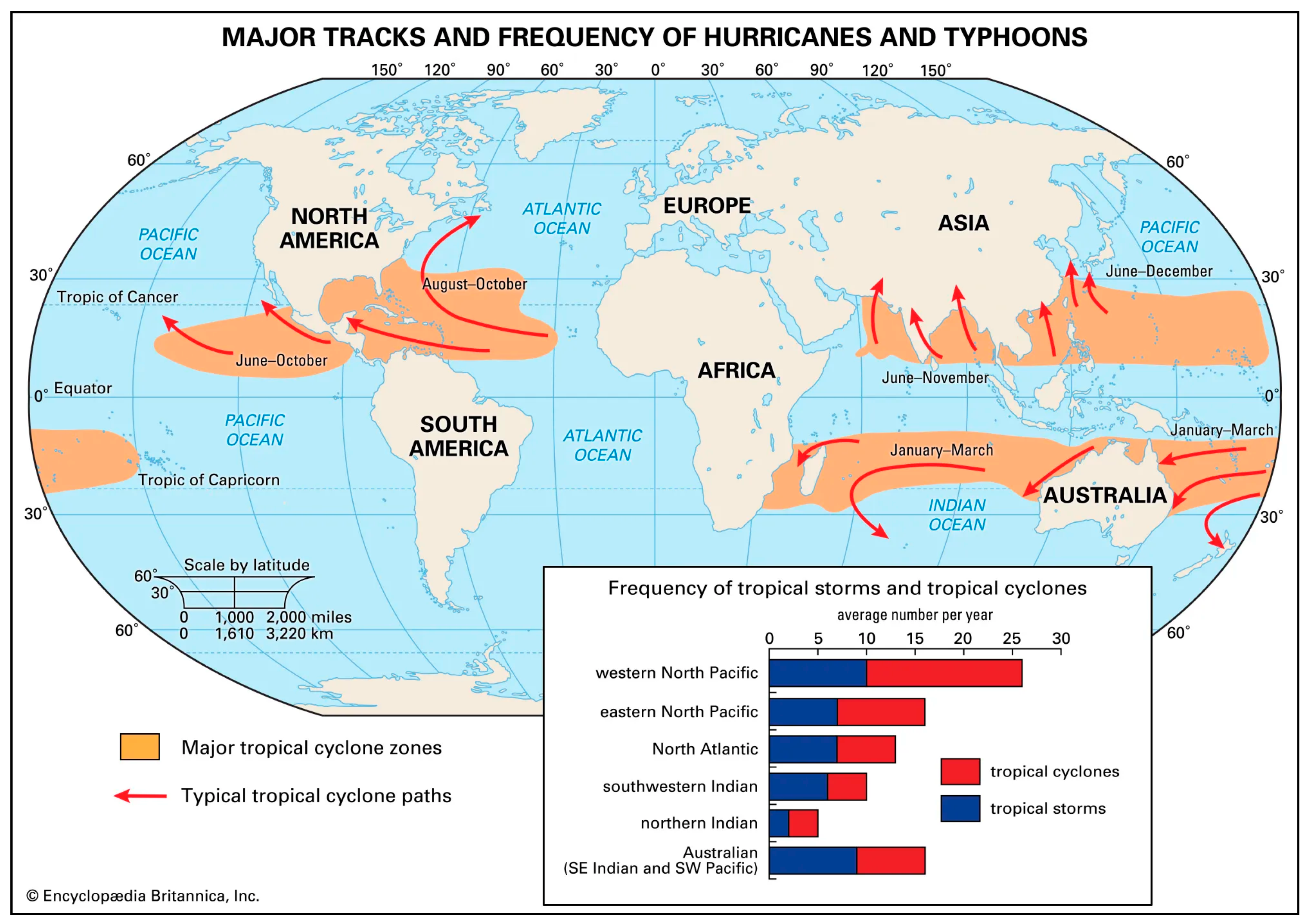

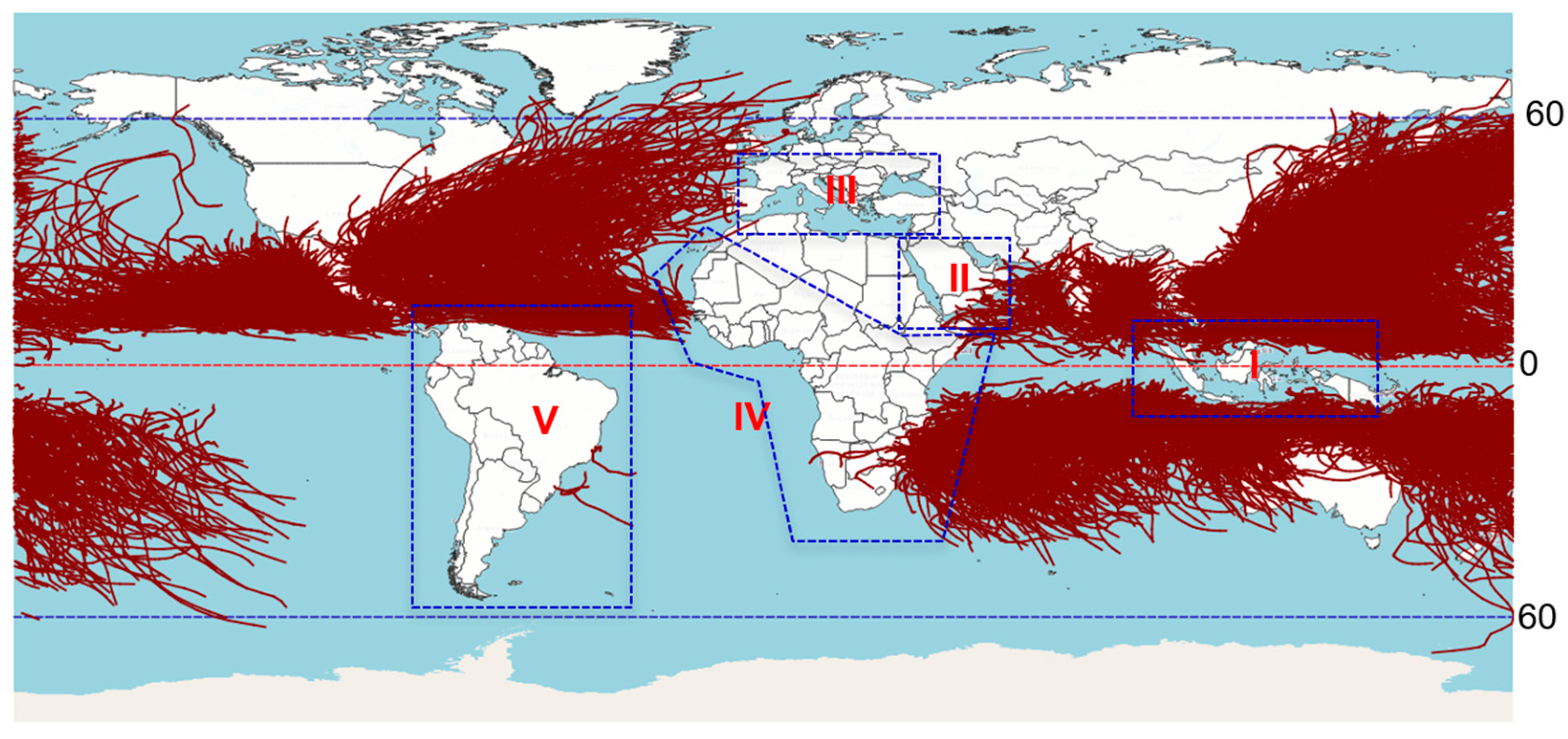

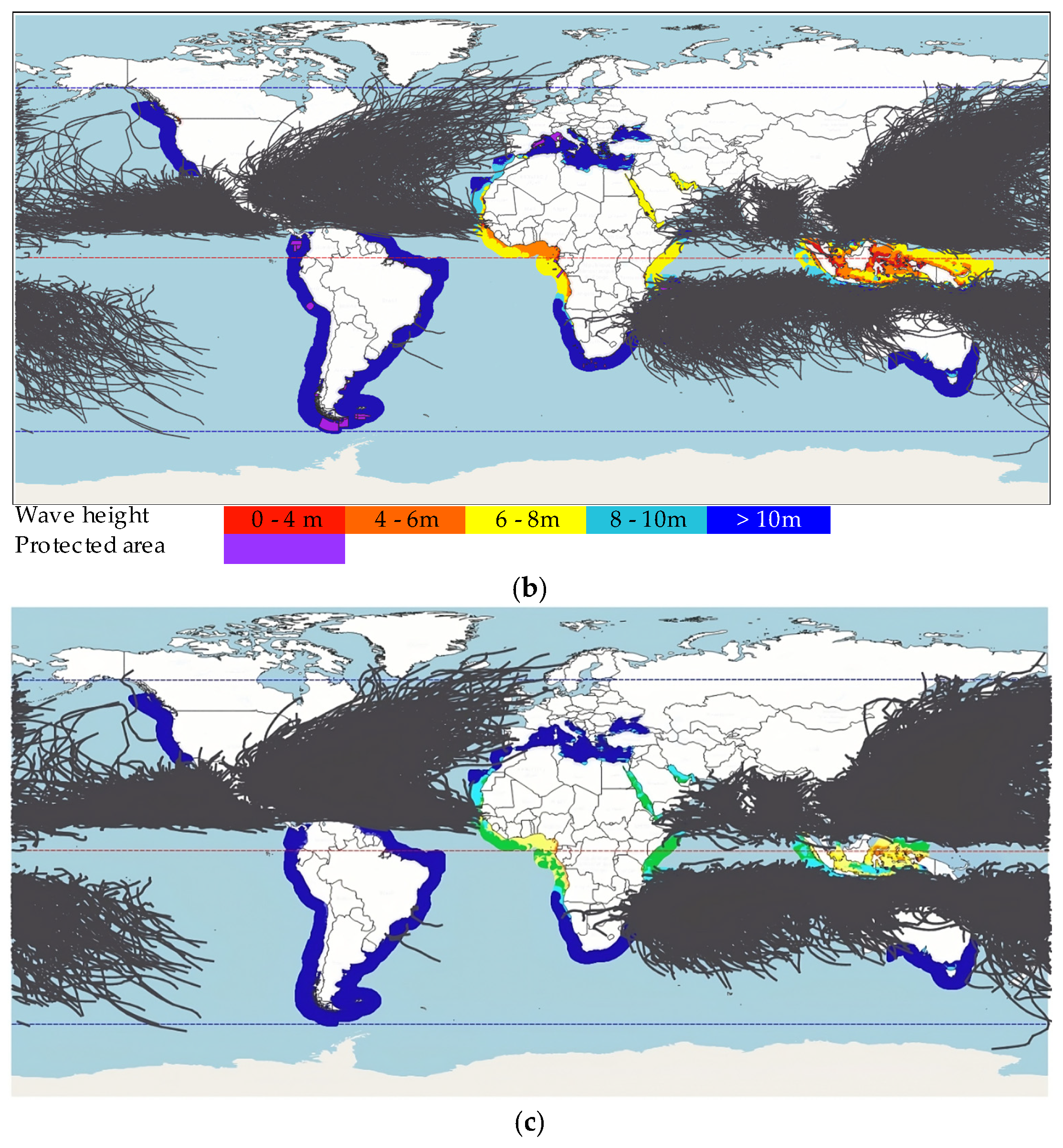
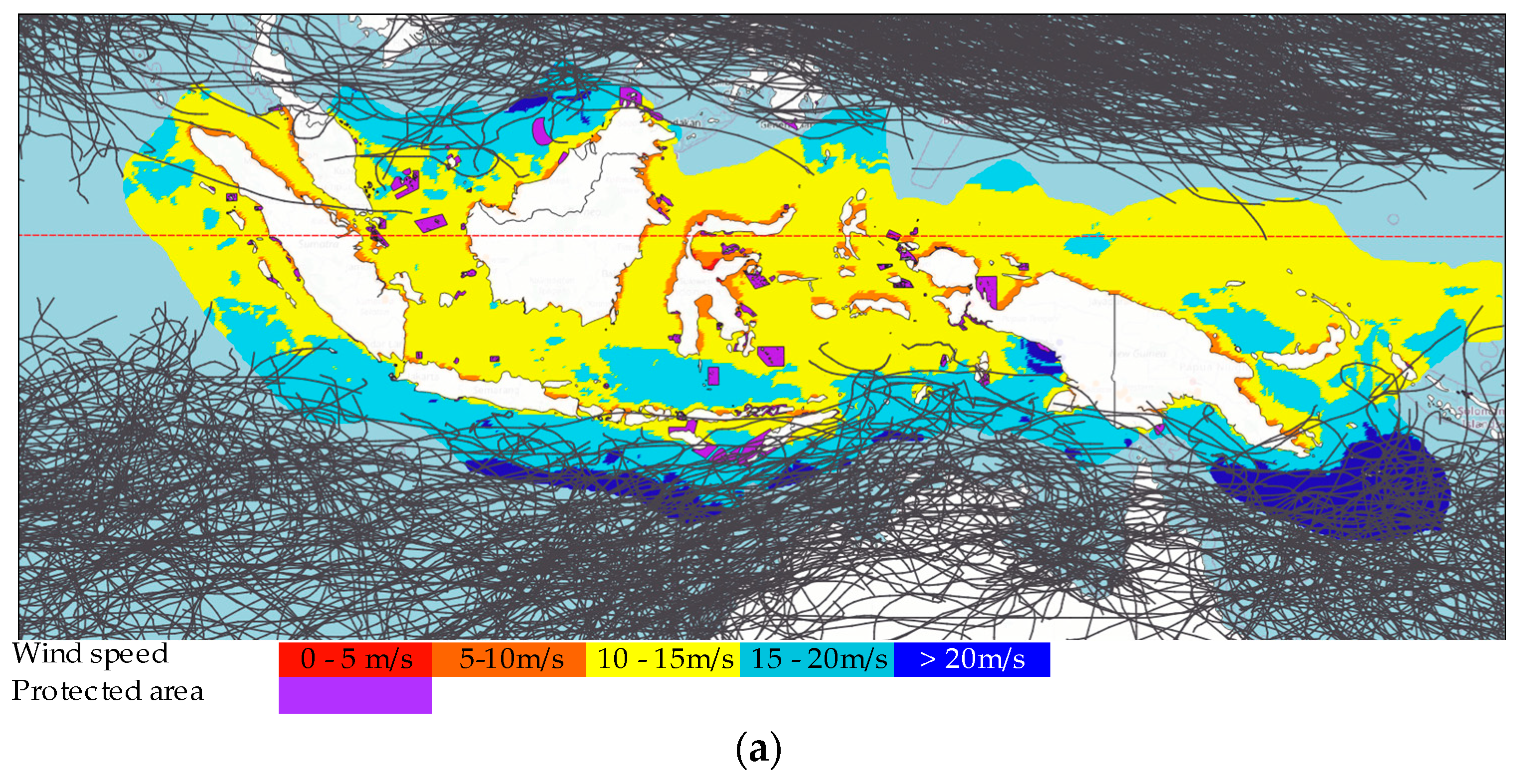
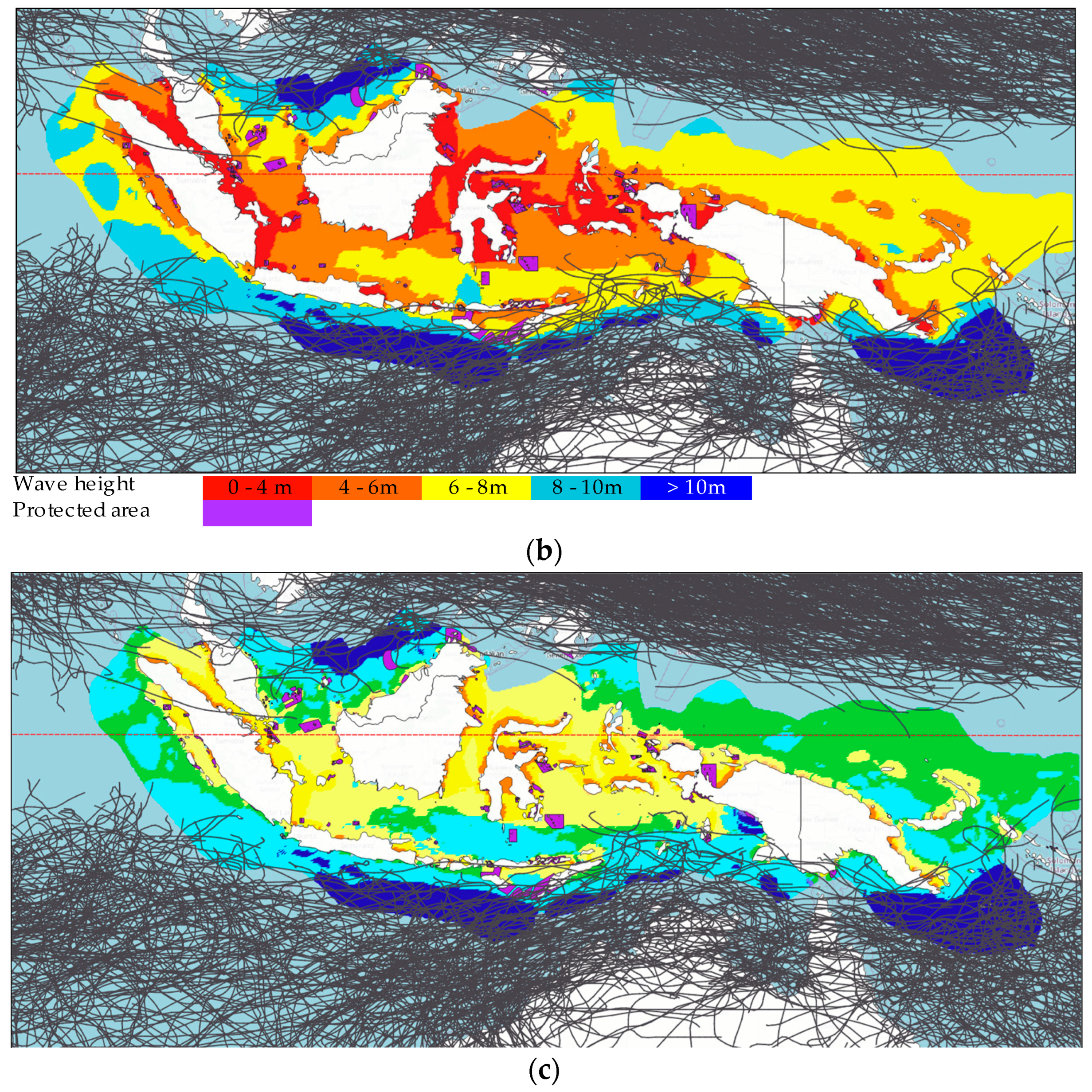

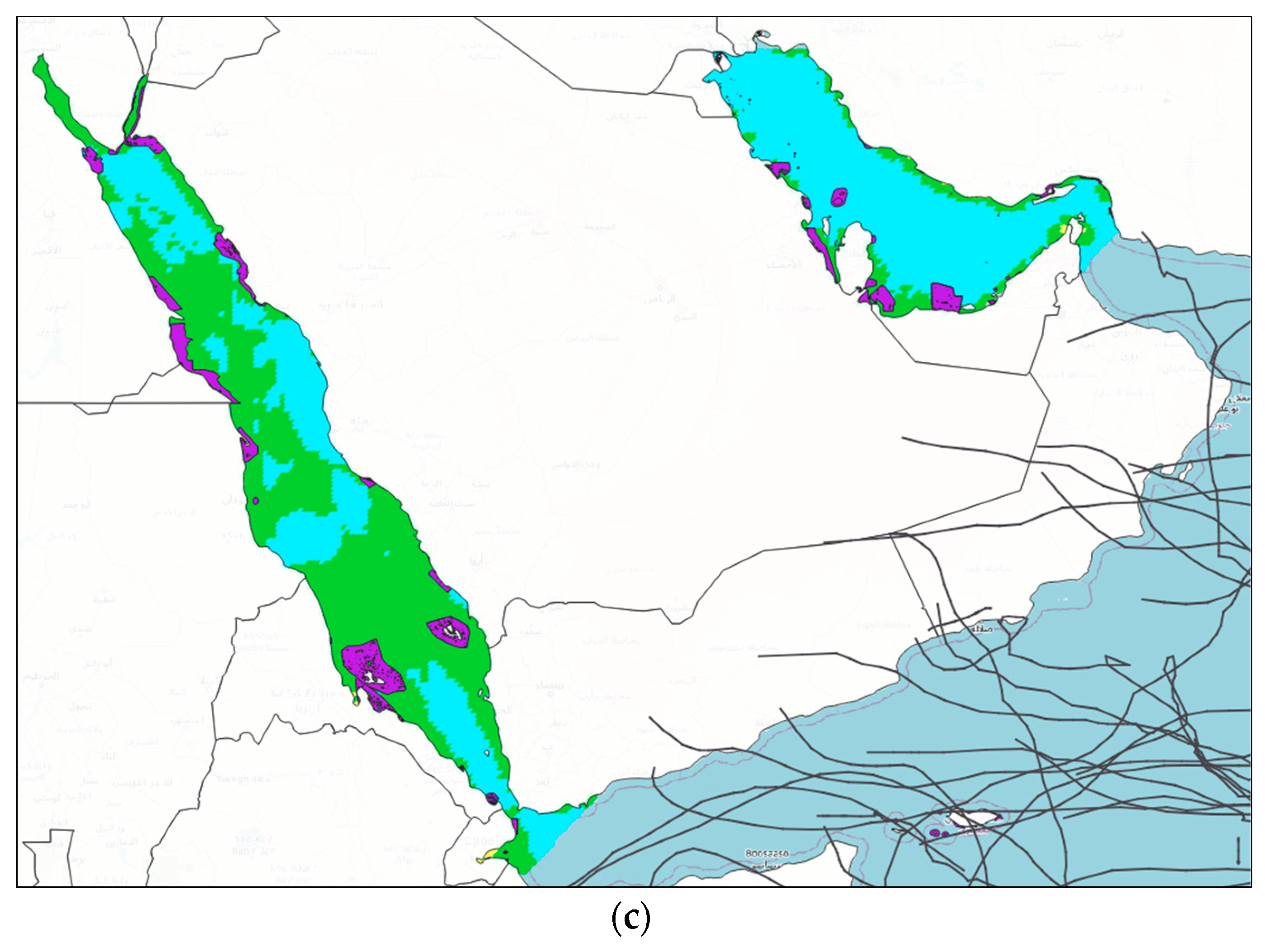
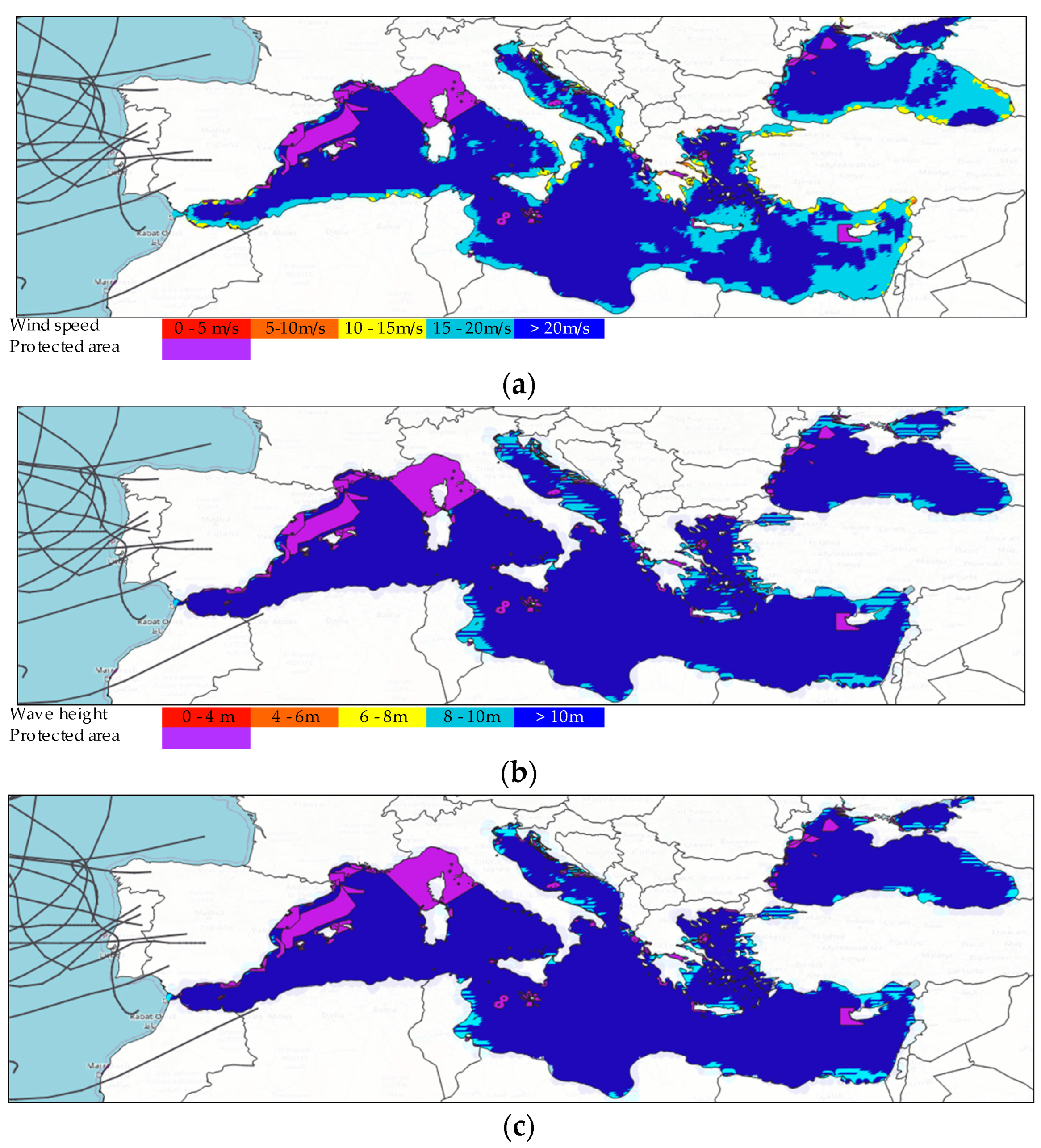
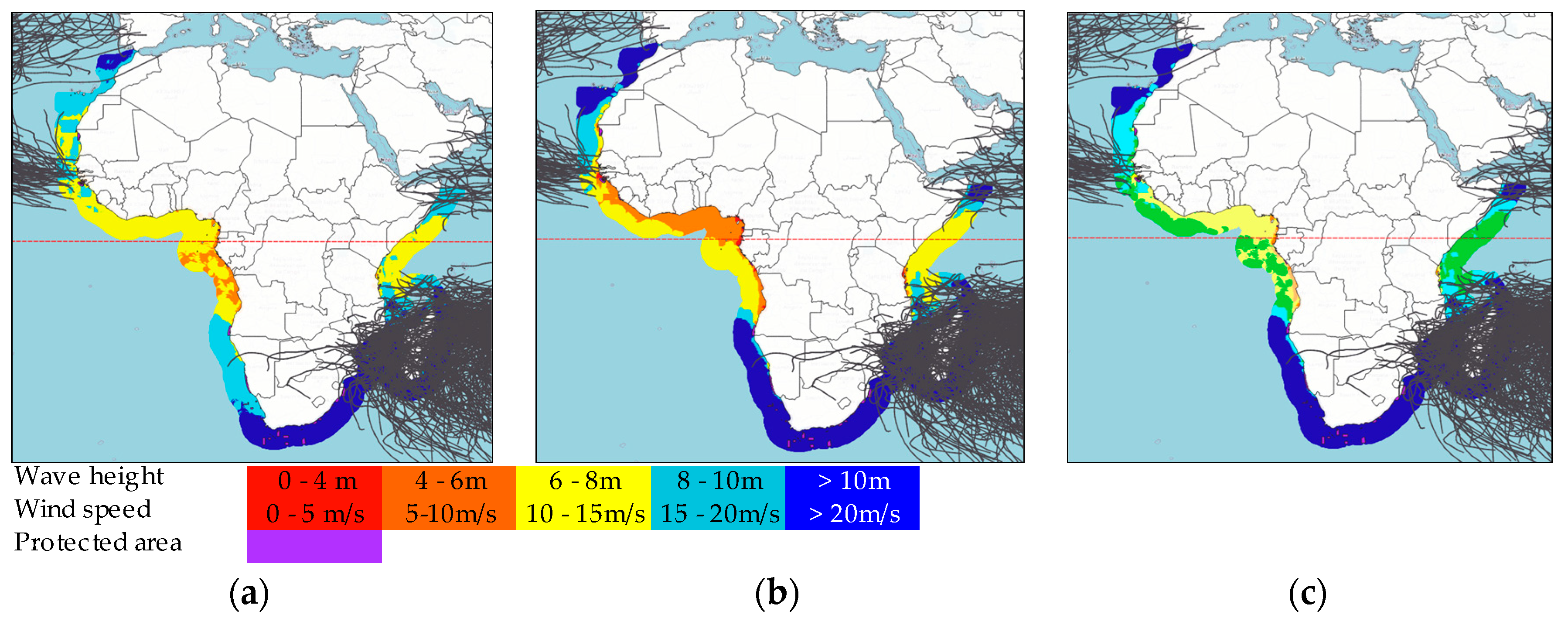
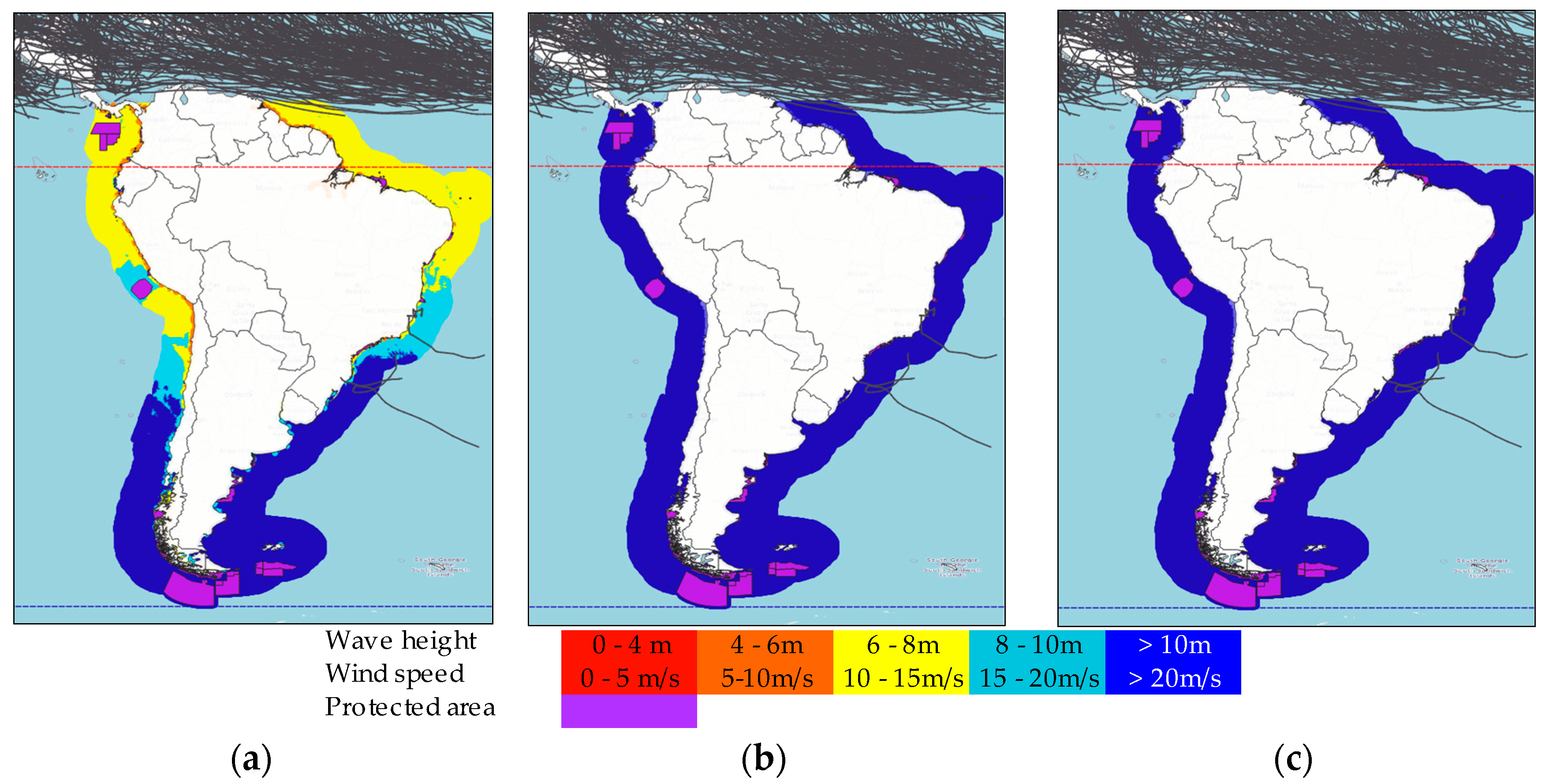
| Wave Height | Wind Speed | ||||
|---|---|---|---|---|---|
| 0–5 m/s | 5–10 m/s | 10–15 m/s | 15–20 m/s | >20 m/s | |
| 0–4 m | 0.1 | 171 | 669 | 8 | - |
| 0.02 | 34 | 134 | 2 | ||
| 0.03 | 45 | 176 | 2 | ||
| 4–6 m | 139 | 2767 | 123 | 4 | |
| - | 28 | 553 | 25 | ||
| 37 | 727 | 32 | |||
| 6–8 m | 214 | 4050 | 1851 | 27 | |
| - | 43 | 810 | 370 | ||
| 56 | 1092 | 513 | |||
| 8–10 m | 0.4 | 493 | 2147 | 147 | |
| - | 0.1 | 99 | 429 | ||
| 0.1 | 129 | 564 | |||
| >10 m | - | 1 | 57 | 2216 | 7538 |
| Wave Height | Wind Speed | ||||
|---|---|---|---|---|---|
| 0–5 m/s | 5–10 m/s | 10–15 m/s | 15–20 m/s | >20 m/s | |
| 0–4 m | 0.1 | 149 | 650 | 6 | - |
| 0.02 | 30 | 130 | 1 | ||
| 0.03 | 39 | 171 | 1 | ||
| 4–6 m | - | 29 | 1776 | 95 | 3 |
| 6 | 355 | 19 | |||
| 8 | 467 | 25 | |||
| 6–8 m | - | 3 | 2115 | 1145 | 19 |
| 1 | 423 | 229 | |||
| 1 | 556 | 301 | |||
| 8–10 m | - | 172 | 1211 | 11 | |
| - | 34 | 242 | |||
| 45 | 318 | ||||
| >10 m | - | - | - | 482 | 624 |
| Wave Height | Wind Speed | ||||
|---|---|---|---|---|---|
| 0–5 m/s | 5–10 m/s | 10–15 m/s | 15–20 m/s | >20 m/s | |
| 0–4 m | - | - | - | - | - |
| 4–6 m | - | - | - | - | - |
| 6–8 m | - | 2 | 318 | 329 | - |
| 0 | 64 | 66 | |||
| 1 | 112 | 115 | |||
| 8–10 m | - | - | 0.1 | 25 | - |
| 0.02 | 5 | ||||
| 0.03 | 9 | ||||
| >10 m | - | - | - | - | - |
| Wave Height | Wind Speed | ||||
|---|---|---|---|---|---|
| 0–5 m/s | 5–10 m/s | 10–15 m/s | 15–20 m/s | >20 m/s | |
| 0–4 m | - | - | - | - | - |
| 4–6 m | - | - | - | - | - |
| 6–8 m | - | - | - | - | - |
| 8–10 m | 0.4 | 11 | 106 | 69 | |
| - | 0.07 | 2 | 21 | ||
| 0.1 | 3 | 26 | |||
| >10 m | - | 0.4 | 16 | 500 | 2079 |
| Wave Height | Wind Speed | ||||
|---|---|---|---|---|---|
| 0–5 m/s | 5–10 m/s | 10–15 m/s | 15–20 m/s | >20 m/s | |
| 0–4 m | 23 | 19 | 2 | ||
| 5 | 4 | 0 | |||
| 6 | 5 | 1 | |||
| 4–6 m | 110 | 991 | 29 | 0 | |
| 22 | 198 | 6 | |||
| 29 | 260 | 8 | |||
| 6–8 m | 209 | 1617 | 271 | 7 | |
| 42 | 323 | 54 | |||
| 55 | 425 | 71 | |||
| 8–10 m | 310 | 804 | 67 | ||
| 62 | 161 | ||||
| 81 | 211 | ||||
| >10 m | - | - | 13 | 1224 | 4794 |
| Wave Height | Wind Speed | ||||
|---|---|---|---|---|---|
| 0–5 m/s | 5–10 m/s | 10–15 m/s | 15–20 m/s | >20 m/s | |
| 0–4 m | - | - | - | - | - |
| 4–6 m | - | - | - | - | - |
| 6–8 m | - | - | - | - | - |
| 8–10 m | - | - | - | - | - |
| >10 m | - | 0.5 | 27 | 10 | 42 |
Disclaimer/Publisher’s Note: The statements, opinions and data contained in all publications are solely those of the individual author(s) and contributor(s) and not of MDPI and/or the editor(s). MDPI and/or the editor(s) disclaim responsibility for any injury to people or property resulting from any ideas, methods, instructions or products referred to in the content. |
© 2023 by the authors. Licensee MDPI, Basel, Switzerland. This article is an open access article distributed under the terms and conditions of the Creative Commons Attribution (CC BY) license (https://creativecommons.org/licenses/by/4.0/).
Share and Cite
Silalahi, D.F.; Blakers, A. Global Atlas of Marine Floating Solar PV Potential. Solar 2023, 3, 416-433. https://doi.org/10.3390/solar3030023
Silalahi DF, Blakers A. Global Atlas of Marine Floating Solar PV Potential. Solar. 2023; 3(3):416-433. https://doi.org/10.3390/solar3030023
Chicago/Turabian StyleSilalahi, David Firnando, and Andrew Blakers. 2023. "Global Atlas of Marine Floating Solar PV Potential" Solar 3, no. 3: 416-433. https://doi.org/10.3390/solar3030023
APA StyleSilalahi, D. F., & Blakers, A. (2023). Global Atlas of Marine Floating Solar PV Potential. Solar, 3(3), 416-433. https://doi.org/10.3390/solar3030023








